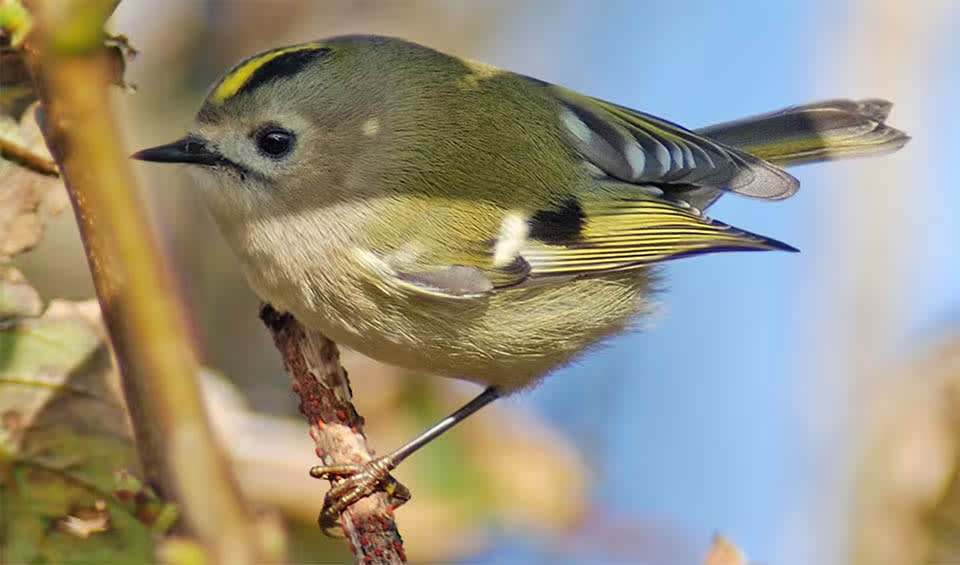The goldcrest is Europe’s smallest bird, a tiny gem that weighs just about the same as a coin. With its vibrant yellow crest stripe atop its head, this bird is not just a delight to spot but also a marvel of nature’s design. The goldcrest’s name comes from this striking feature: a golden stripe bordered by black that runs across the top of its head, more prominent in males than in females. This colorful crest can be raised and fanned, especially during courtship or territorial disputes, adding to its distinctive appearance.
Goldcrests inhabit coniferous woodlands, gardens, and parks across Europe and parts of Asia. They are especially fond of spruce and fir trees where they can forage for insects and spiders. Their diet primarily consists of small invertebrates, which they adeptly pick from the bark and leaves with their fine, needle-like beaks. The agility of goldcrests is noteworthy; they often hang upside down on twigs to reach their prey, showcasing their acrobatic skills.
Goldcrests are resident birds in many parts of their range, but those living in the colder northern areas migrate southwards to escape the harsh winters. This migration is a risky journey due to their small size and the large distances involved. Yet, their presence in various parts of Europe, even during winter, is a testament to their resilience.
A fun fact about the goldcrest is its association with folklore. In Victorian times, it was often called the “king of the birds” in European folklore due to its regal crest and the old tale that describes it winning a competition among birds to fly the highest by hitching a ride on the back of an eagle, only to fly higher on its own when the eagle tired.
Distribution
 Afghanistan
Afghanistan Albania
Albania Algeria
Algeria Andorra
Andorra Armenia
Armenia Austria
Austria Azerbaijan
Azerbaijan Belarus
Belarus Belgium
Belgium Bhutan
Bhutan Bosnia And Herz.
Bosnia And Herz. Bulgaria
Bulgaria China
China Croatia
Croatia Cyprus
Cyprus Czechia
Czechia Denmark
Denmark Estonia
Estonia Faroe Islands
Faroe Islands Finland
Finland France
France Georgia
Georgia Germany
Germany Greece
Greece Hungary
Hungary Iran
Iran Ireland
Ireland Israel
Israel Italy
Italy Japan
Japan Kazakhstan
Kazakhstan Korea
Korea Kyrgyzstan
Kyrgyzstan Latvia
Latvia Lebanon
Lebanon Liechtenstein
Liechtenstein Lithuania
Lithuania Luxembourg
Luxembourg Malta
Malta Moldova
Moldova Mongolia
Mongolia Montenegro
Montenegro Myanmar
Myanmar Nepal
Nepal Netherlands
Netherlands North Korea
North Korea North Macedonia
North Macedonia Norway
Norway Poland
Poland Portugal
Portugal Romania
Romania Russia
Russia Serbia
Serbia Slovakia
Slovakia Slovenia
Slovenia Spain
Spain Sweden
Sweden Switzerland
Switzerland Tajikistan
Tajikistan Tunisia
Tunisia Turkey
Turkey Ukraine
Ukraine United Kingdom
United Kingdom Uzbekistan
UzbekistanAnything we've missed?
Help us improve this page by suggesting edits. Glory never dies!
Suggest an editGet to know me
Terrestrial / Aquatic
Altricial / Precocial
Polygamous / Monogamous
Dimorphic / Monomorphic (size)
Active: Diurnal / Nocturnal
Social behavior: Solitary / Pack / Flock
Diet: Carnivore / Herbivore / Omnivore / Piscivorous / Insectivore
Migratory: Yes / No
Domesticated: Yes / No
Dangerous: Yes / No




